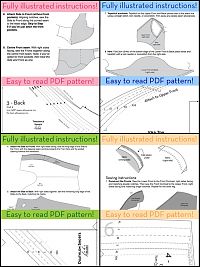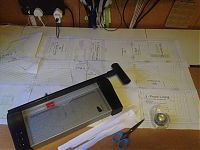There’s been some discussion around the internet lately about pdf patterns and their ability to stand the test of time, and it’s one that I’ve felt very strongly about. I’ve worked in technology for over 12 years, and have created and run my own websites for 20 years now (seriously!). I’ve seen the world move from owning cds and taking photos to be developed, to ripping cds into mp3s and printing our own digital photos, right through to streaming music subscriptions and purely-digital photos in the cloud. The idea that digital patterns might somehow die out seems absurd when you think of it in this context.
Think of photos – which is more accessible when you want to look at them, the photos in your album on the shelf at home, or the ones backed up in your cloud account you can view from anywhere, share, and search by date and keyword? Frankly, I’m terrified that my 10 year old collection of Burda magazine patterns might be ruined in a fire or flood, because they’d be gone forever. But my digital patterns are backed up in several places, ready for me to re-print at any time.
But all this is from a user perspective. As a business owner, why would I not want to offer my patterns in every format possible? Why only pdf patterns?
In short, time and money. It’s grossly inefficient (not to mention extremely eco-unfriendly) for me to print a pattern and ship it halfway around the globe to customers when printing places exist closer to you. Adding on the cost to print the patterns, to package them, and then my time in posting them, I’d quickly end up with a price point that not very many people would be willing to spend.
Making the choice to only sell pdf patterns means I can keep costs low for my customers, and spend my time developing new patterns instead of fulfilling orders and walking to the post office. You get the pattern instantly, without having to wait for the post, too. There’s nothing worse than getting excited about a project then waiting two weeks before you can even get started!
“But assembling pdf patterns takes forever!”
I’m going to go out on a limb here and say that you’re probably doing it wrong. Earlier this year I watched some people put together some pdf patterns who’d never encountered them before. They sat down with their scissors and diligently cut off all four sides of every pattern page, then laid everything out and taped every single join along its entire length. My eyes boggled.
If you’re doing this, definitely have a read through Sewaholic’s post on quickly assembling Print At Home pdf patterns – it’s very close to the way I assemble pdf patterns, and it takes me roughly 1min per page (so a 15 page pattern takes me about 15min to trim, assemble, and cut). And I assemble a lot of pdf patterns during the development process!
A few more tips for assembling:
- Try using gluestick instead of tape, as it’s easier to adjust and nudge pieces if they’re slightly off-kilter
- A cheap guillotine cutter can really speed up trimming edges and is easier on your hands than scissors
- Invest in a laser printer. Our last black laser toner cartridge lasted us 4 years.
- Buy the cheapest printer paper available. It’ll likely also be the thinnest, which makes storing patterns afterwards easier and is less effort to cut through.
Or if you’ve tried the above and still really don’t like assembling patterns (which is fine!), most pattern companies offer a large format version of the pattern which you can take to a copy shop and get printed onto a large sheet of paper. I’ve always offered these “Copy Shop” versions, but I’ve recently changed to include copy shop versions in all my purchases by default rather than by request to cut down on the time delay for you all.
If you’re having trouble finding somewhere near you to print these out economically (they really shouldn’t cost more than about £5/$8 for the average pattern), then you may want to read this Pattern Review discussion on finding cheap places to print large format pdfs. It’s US-based, but a lot of the tips (like asking for engineering or architectural prints when getting quotes) are applicable anywhere.
So, after all this – it doesn’t necessarily mean I will never offer printed patterns for sale – just that the current infrastructure and price isn’t there to support it yet. I would consider selling printed patterns should there be a company which handles the printing and order fulfillment for local customers, for example. Or if I were to have a stall at an expo and sell patterns in person. Or should drone technology advance so that I can have an automated way of delivering direct to those in my local area (am I the only one who sees the potential good in drones, like the Harry Potter owl postal system?).
But I do definitely see that digital patterns are the way the industry is headed, and for all the reasons outlined above, I vastly prefer them both as a customer, and as a patternmaker.
Oh, and I’ve got a freebie pattern coming out very soon…


